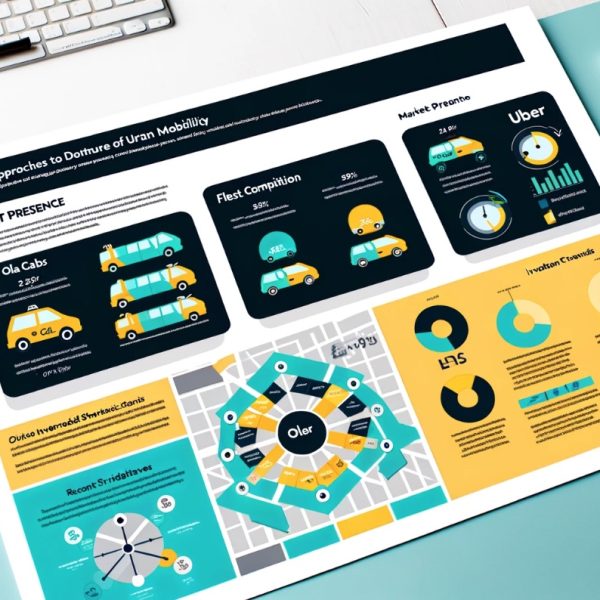Ola vs Blusmart vs Uber: Ride-Hailing Giants Gear Up for a Greener Future
February 18, 2024
Industry: ride hailing
Subject: Startups

Ola Cabs, Uber, and BluSmart showcase diverse business models within the ride-hailing sector. Ola has expanded from ride-hailing to a broader mobility platform, incorporating EVs and financial services, aiming for sustainable transportation. Uber, with a global presence in 69 countries, leverages extensive data for fleet and pricing management, offering ride-hailing, food delivery, and freight services. BluSmart differentiates with an all-electric fleet, focusing on sustainability and predictable pricing, devoid of surge charges. These strategies reflect their unique market positioning, with Ola and BluSmart emphasizing environmental sustainability, and Uber focusing on global scale and service diversification.
Business Models and Market Positioning
Ola Cabs: Founded in 2010 by Bhavish Aggarwal and Ankit Bhati, Ola has evolved from a ride-hailing service to a diversified mobility platform offering various services including bike taxis, auto-rickshaws, and electric vehicles (EVs) through its subsidiary, Ola Electric. Ola’s business model is built on a network of contracted drivers and a wide range of vehicle options to cater to different customer needs. Ola has also ventured into electric mobility and financial services, indicating a strategic pivot towards sustainable transportation and fintech solutions.
Uber: Launched in 2009 by Travis Kalanick and Garrett Camp, Uber’s global footprint surpasses that of Ola, operating in around 69 countries. Uber’s model is similar to Ola’s but with a larger scale and scope, including ride-hailing, food delivery (Uber Eats), and freight services (Uber Freight). Uber’s extensive data on user preferences and traffic patterns enables it to efficiently manage its fleet and pricing strategies, making it a formidable player in the markets it operates.
BluSmart: As a newcomer, founded in 2019 by Anmol Jaggi and Punit K Goyal, BluSmart stands out by offering an all-electric ride-hailing service. Its business model focuses on sustainability, aiming to reduce carbon emissions and promote the use of EVs in urban transportation. BluSmart operates with a fleet of owned and operated electric vehicles, distinguishing itself from the asset-light models of Ola and Uber. This approach not only promotes environmental sustainability but also offers a unique value proposition in the form of predictable pricing and no surge pricing.
Valuation and Investors
Ola Cabs, operated by ANI Technologies, has seen a notable adjustment in its valuation by the U.S. asset manager Vanguard. As of early 2024, Vanguard reduced Ola Cabs’ valuation by about 30% to under $2 billion, marking it down to approximately $1.88 billion. This adjustment reflects a significant decrease from its previous valuation of around $2.65 billion in August 2023 and a peak of $7.3 billion in prior fundraising rounds. The revaluation comes amid a challenging market environment, including a price war with Uber and the emergence of niche players like BluSmart, which have intensified the competitive landscape. Despite narrowing its losses by 65% to about $130.5 million in fiscal 2023, Ola Cabs has yet to report a profit. The company is also focusing on expanding into electric mobility through its subsidiary, Ola Electric, which is eyeing to raise $662 million in an initial public offering.
Uber, being publicly listed, provides more transparency in its valuation, which reflects its global leadership in ride-hailing and food delivery services. Uber’s market capitalization, as of February 2024, stands at approximately $167.49 billion. This figure underscores Uber’s significant valuation and its position as a major player in the global ride-hailing and mobility services market, reflecting investor confidence in its business model, global reach, and diversified service offerings..
BluSmart, although smaller in valuation compared to Ola and Uber, has shown impressive growth. BluSmart is currently valued at $250 million, as per the latest information available. This valuation reflects the company’s position as a significant player in the electric vehicle ride-hailing market, focusing on sustainability and green transportation solutions. BluSmart’s approach differentiates it from traditional ride-hailing services by emphasizing eco-friendly transportation options, aligning with global trends towards environmental responsibility and sustainability in urban mobility.
Competitive Landscape and Strategic Moves
Ola has been aggressively expanding its electric vehicle offerings, launching Ola Electric and committing to setting up a vast network of charging infrastructure across India. This move not only positions Ola as a leader in the EV space but also aligns with global trends towards sustainability.
Uber continues to invest in technology to enhance user experience and operational efficiency. Its global strategy focuses on maintaining leadership in existing markets while exploring new services and technologies, including autonomous vehicles and urban air transport.
BluSmart, with its unique positioning in the electric ride-hailing market, focuses on expanding its fleet and charging infrastructure. The company aims to capitalize on the growing demand for sustainable transportation options, setting itself apart from competitors with its green initiative.
Conclusion and Insights
Market Leadership and Innovation: Uber remains a global leader due to its extensive market presence and diverse service offerings. Ola, with its strong foothold in India and strategic expansion into electric mobility, is poised for significant growth. BluSmart, though a niche player, is leading the charge in sustainable urban mobility, presenting a compelling case for the future of ride-hailing.
Strategic Positioning for Future Growth: The focus on electric vehicles by Ola and BluSmart highlights a strategic shift towards sustainability, aligning with global environmental goals. Uber’s investment in technology and new mobility solutions positions it as a forward-thinking player ready to adapt to future transportation trends.
Investor Confidence and Expansion Potential: The diverse strategies of these companies reflect their adaptability and potential for growth. Ola and BluSmart’s focus on the Indian market, with its rapid urbanization and growing environmental consciousness, presents a significant opportunity. Uber’s global presence and operational scale offer a different kind of growth potential, underpinned by technological innovation and market diversification.
see also Grab vs Uber vs Ola
—
| Aspect | Ola Cabs | Uber | BluSmart |
|---|---|---|---|
| Founding Year & Founders | 2010 by Bhavish Aggarwal and Ankit Bhati | 2009 by Travis Kalanick and Garrett Camp | 2019 by Anmol Jaggi and Punit K Goyal |
| Business Model | Diversified mobility platform offering ride-hailing, bike taxis, auto-rickshaws, EVs through Ola Electric, and financial services. Operates on a network of contracted drivers with a wide range of vehicle options. | Global ride-hailing, food delivery (Uber Eats), and freight services (Uber Freight) with a model based on extensive data on user preferences and traffic patterns to manage fleet and pricing. | All-electric ride-hailing service focusing on sustainability by operating a fleet of owned and operated electric vehicles. Offers predictable pricing with no surge pricing. |
| Market Positioning | Strong foothold in India with strategic expansion into electric mobility and fintech solutions. | Global presence in around 69 countries, leading in ride-hailing and diversifying into food delivery and freight services. | Niche player in the electric vehicle ride-hailing market, emphasizing eco-friendly transportation options. |
| Valuation & Investors | Valued at approximately $1.88 billion as of early 2024, with a focus on expanding into electric mobility through Ola Electric. | Market capitalization of approximately $167.49 billion as of February 2024, reflecting significant global leadership and investor confidence. | Valued at $250 million, focusing on sustainability and green transportation solutions. |
| Competitive Landscape | Aggressively expanding in the EV space with Ola Electric and setting up charging infrastructure in India. | Invests in technology for user experience and operational efficiency, exploring new services like autonomous vehicles and urban air transport. | Focusing on expanding its fleet and charging infrastructure to capitalize on the demand for sustainable transportation options. |
| Strategic Insights | Poised for growth with a focus on the Indian market and electric mobility. | Remains a global leader with a diverse service offering and a strategy to adapt to future transportation trends. | Leading the charge in sustainable urban mobility with a unique value proposition in the EV ride-hailing market. |








